Main content starts here.
Foreign Languages > Chiba International Information Square - To foreign residents - > Chiba Nanohana News > Chiba Nanohana News (Past Issues) > Chiba Nanohana News (June 2025)
Update: June 30, 2025
Chiba Nanohana News (June 2025)
Index
I. News II.Festivals and Events
I. News
1)Typhoon and Heavy Rain Preparedness
Torrential rains, heavy rainfall that is concentrated in a limited area within a short period of time, often occur toward the end of the rainy season. Significant damage from river flooding and landslides can be expected. This is also the beginning of typhoon season. Many typhoons either pass by or hit Japan every year, bringing heavy rains and strong winds that can cause extensive damage. Pay close attention to weather reports and information from your local municipality and take all possible precautions.
<Early Evacuation>
- Determine what kinds of hazards may exist in or around your home, school, and workplace.
- Review hazard maps and local disaster prevention plans prepared by your local municipality to identify the kinds of hazards present at the places that you frequent, such as how many meters of water it will take to flood certain locations or what areas are prone to landslides.
- Check the locations of evacuation shelters as designated by your municipality and plan your route and means of getting there.
- Find out how to access evacuation information. You can obtain them through your municipality’s website, the Safety Tips app, or other official sources. The proper timing for evacuation will be announced according to the Warning Levels.
- Level 3 (Evacuation of the Elderly): Those who require more time to evacuate, including the elderly and those with young children, must evacuate from hazardous areas.
- Level 4 (Evacuation Order): Everyone must evacuate from hazardous areas.
- Level 5 (Emergency Safety Measures): Take immediate action to protect yourself.
Chiba Prefecture “Disaster Prevention Handbook” ![]() (available in English, Chinese (simplified/traditional), and easy Japanese)
(available in English, Chinese (simplified/traditional), and easy Japanese)
Chiba Prefecture Disaster Prevention Portal Site![]() (available in multiple languages)
(available in multiple languages)
“Safety Tips” (a push notification-enabled information alert app for international visitors, available in multiple languages)
II.Festivals and Events
1)Seasonal flower: Hydrangea
What flowers brighten up early summers? Hydrangeas! They bloom in an array of colors during tsuyu (the rainy season), showing a different charm than on a sunny day. Grab your favorite umbrella and take a stroll through the hydrangeas!
1. Hattori Farm Hydrangea House (Mobara City)
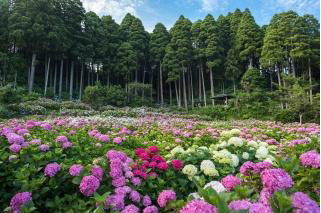
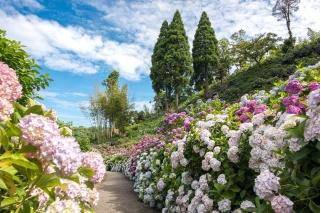
Hattori Farm Hydrangea House is an extensive 27,000-square-meter facility. From early June to early July, more than 10,000 bushes of 250 varieties of hydrangeas covered every bit of 18,000-square-meter of the land in fresh blooms. The hydrangeas are planted on slopes, so regardless of where you stand, whether viewing from above or from below, all you see is a pure panorama of beauty. This is why visitors from within and outside Chiba Prefecture make the trip to Hattori Farm Hydrangea House, one of the sightseeing spots that best represents Mobara.
As the path may be muddy or steep at certain points, we recommend coming in clothes that you do not mind getting dirty and sensible shoes such as sports shoes that you are used to wearing.
- Viewing period: early June to early July 2025
- Location: Hattori Farm Hydrangea House, 719 Sangaya, Mobara City
- Time: 8 a.m. to 6 p.m.
- Closing days: None during this period
- Entrance fee: Adults (junior high school students and above) 600 yen, elementary school students 300 yen
- Access: 15-minute drive from Mobara-Chonan IC on the Ken-O Expressway
- Inquiries: Hattori Farm Hydrangea House TEL: 0475-24-8511
- Hattori Farm Hydrangea House website

2. Mano-ji Temple (Minamiboso City)
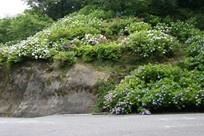
Mano-ji Temple, a temple in the Manotani area with a long history, which is known as a “flower temple”, is now holding a Hydrangea Festival until July 6 (Sunday) with 3,000 bushes of hydrangeas in bloom. The 6th of every month is an auspicious day and ceremonies such as the Goma-taki, a cleansing ceremony using fire, will be conducted then. The goshuin (temple stamp) will be a special seasonal design featuring hydrangeas
- Viewing period: early June to early July
- Goshuin: available
- Location: Mano-ji Temple, 587 Kubo, Minamiboso City
- Access: 25-minute drive from Futtsu IC on the Futtsu-Tateyama Expressway
- Inquiries: 0470-46-2590
- Mano-ji Temple website

3. Nichiun-ji Temple (Minamiboso City)
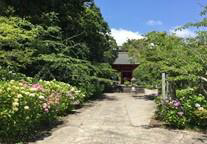
A hidden spot for hydrangeas, Nichiun-ji Temple is an ancient temple which is also known as “Boso’s hydrangea temple”. A large variety of 20,000 bushes of hydrangeas are planted along the entrance and in the temple ground. The vermillion Nio-mon main entrance was erected in 1726 and its eight elegant, round pillars each with an octagonal base is a sight to behold. The charm of the vermillion, framed by the hydrangeas, stands out and catches the eye.
- Viewing period: early June to early July
- Goshuin: available
- Location: 2124 Kamo, Minamiboso City
- Access: 25-minute drive from Futtsu IC on the Futtsu-Tateyama Expressway
- Inquiries: 0470-46-2196
2) Ume~mon Nyubai Iwashi Festival (Choshi City, Asahi City, and more)
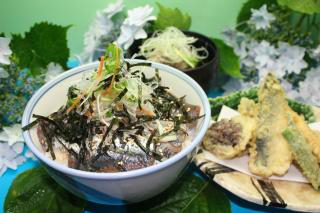
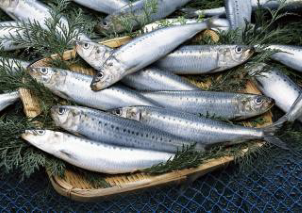
As the rainy season falls upon Choshi City and the fatty Nyubai iwashi (sardines) come into season, you can enjoy them at the Ume~mon Nyubai Iwashi Festival. Caught from the rough waters off the coast of Choshi, the sardines are firm fleshed and put on fat during the rainy season, resulting in a melt-in-the-mouth texture. Six restaurants from the Choshi Ume~mon Research Association have prepared a delicious meal out of the fattiest sardines in the year, known as Nyubai iwashi, for your pleasure.
★ All restaurants will provide the same “Nyubai Iwashi Omakase Meal” for 3,000 yen (tax inclusive)
* You must make a reservation by phone call.
Period: June 1, 2025 (Sunday) to July 31, 2025 (Thursday)
Location, telephone number, access:
- Zen Hanare, 11300-2 Inuwaka, Choshi City
TEL: 0479-23-5730
13-minute walk from Tokawa station (Choshi Dentetsu) - Donya Shichibe, 1-26 Iinumacho, Choshi City
TEL: 0479-25-3133
5-minute walk from Kannon station (Choshi Dentetsu) - Country House Tsuberi, 1217 Kaminagai, Asahi City
TEL: 0479-57-3190
20-minute taxi from Iioka station (JR Sobu Main Line) - Hirohan (in Choshi Plaza Hotel), 11-2 Nishishibacho, Choshi City
TEL: 0479-22-0070
3-minute walk from Choshi station (JR Sobu Main Line) - Hobo-Tatsumi, 473 Miyabaracho, Choshi City
TEL: 0479-33-3198
20-minute walk from Shimosa Toyosato station (JR Narita Line) - Hanazushi / 6558-4 Hasaki, Kamisu City, Ibaraki Prefecture
- TEL: 0479-44-2457
10-minute drive from Choshi Station (JR Sobu Main Line)
Inquiries: Choshi City Tourism and Commerce Division![]()
TEL: 0479-24-8707
